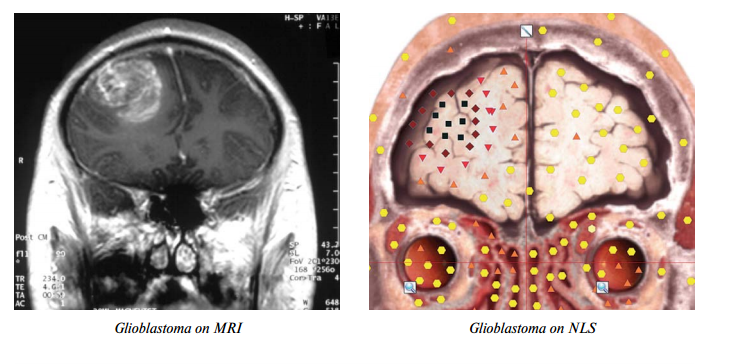

Combined radiation therapy and metatherapy of glioblastoma in elderly patients Rengan J., Turrisi T. Methods and course of the study The present study was carried out in several clinics of France. The study involved 81 patient of 70 and above with incurable glioblastoma of brain. Karnofsky scale point was 6 МВ, 1.8 Gy once per day, 5 days in a week; total dose of radiation – 50 Gy. Additional treatment included application of «Metatherapy» using «3D-NLS» system, one session once in a day for 1 – 2 minutes to affected region of brain. Supportive therapy consisted of corticosteroids, anticonvulsant, professional help of psychologist and palliative treatment team. First of all patients were operated on and randomly divided into two groups: the first (control) group (42 patients) was subjected to symptomatic treatment and radiation therapy (RT) only, the second group (experimental – 39 patients) along with supportive treatment was subjected to radiation therapy (RT) together with «Metatherapy». RT method was the following: radiation of region with increased accumulation of contrast in a tumor in accordance with MRI + «safety zone» of 2 cm wide around it. Linear accelerator photons with nominal energy were applied. Quality of life was evaluated in accordance to EORTC QLQ-C30, version 2.0 and its module specially created brain tumors - QLQ-BN20. Evaluation of brain condition was carried out by means of the following systems: Mini– Mental State Examination – MMSE, Mattis Dementia Rating Scale - MDRS and Neuropsychiatric Inventory. Progressing of a tumor was understood as increasing of tumor size by 1/4 and more, and also as development of metastases in accordance with CT, MRI and NLS. The main criterion for comparison of treatment effectiveness was general survival rate. The secondary criteria were: survival rate without tumor progressing, tolerance to treatment, quality of life, cognitive function. Results Median of observation was 21 weeks. During this period 69.1% of all studied patients died. However certain indices were much better in experimental group in comparison with control group: Experimental group (RT + Metatherapy) Control group General survival rate, median 39.1 weeks 16.9 weeks Relative death risk for general survival rate (practically, death risk ratio) 0.32 1 Survival rate without tumor progressing, median 18.9 weeks 5.4 weeks Relative risk of disease development 0.2 1 To the date there are no standards of brain glioblastoma therapy in patients above 70. This type of tumors is characterized by unfavorable clinical course at any age. If glioblastoma develops in an elderly patient, a therapist faces even more complicated problem, because at that age a patient’s tolerance to anti-tumor treatment is much worse. What can a therapist do in such case – carry out supportive therapy only or try to slow down tumor development using radiation? -62- Indices of quality of life, cognitive activity and index of neuro-psychiatric evaluation were steady declined in researched patients with course of time, at the same time these indices in both groups were significantly different. Radiation reaction for RT in combination with Metatherapy was minimal. Only in one patient somnolentia transient syndrome developed shortly after radiation.
